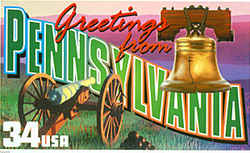- » 50 States
- » Histories
- » State Symbols
- » Seals
Pennsylvania State Seal
Great Seal of the State of Pennsylvania

Adopted in 1791.
The Pennsylvania State Seal is the symbol used by the Commonwealth to authenticate certain documents. It is impressed upon the document by an instrument known as a seal-press or stamp. The State Seal has two faces: the obverse, which is the more familiar face and the one most often referred to as the "State Seal," and the reverse, or counter-seal, which is used less frequently. The State Seal is in the custody of the Secretary of the Commonwealth. When Pennsylvania was still a province of England, its seals were those of William Penn and his descendants. The transition from this provincial seal to a state seal began when the State Constitutional Convention of 1776 directed that "all commissions shall be . . . sealed with the State Seal," and appointed a committee to prepare such a seal for future use. By 1778, there was in use a seal similar to the present one. The seal received legal recognition from the General Assembly in 1791, when it was designated the official State Seal.
Pennsylvania Great Seal
Description of the Pennsylvania Seal
The obverse of the seal contains a shield upon which are emblazoned a sailing ship, a plough, and three sheaves of wheat. To the left of the shield is a stalk of Indian corn; to the right, an olive branch. The shield's crest is an eagle, and the entire design is encircled by the inscription "Seal of the State of Pennsylvania." These three symbols, the plough, ship, and sheaves of wheat, have despite minor changes through the years remained the traditional emblems of Pennsylvania's State Seal. They were first found in the individual seals of several colonial Pennsylvania counties which mounted their own identifying crests above the existing Penn Coat of Arms. Chester County's crest was a plough; Philadelphia County's crest was a ship under full sail; Sussex County, Delaware (then a part of provincial Pennsylvania) used a sheaf of wheat as its crest. The shield of the City of Philadelphia contained both a sheaf of wheat and a ship under sail. It was a combination of these sources that provided the three emblems now forming the obverse of the State Seal.

The reverse of this first seal shows a woman who represents liberty. Her left hand holds a wand topped by a liberty cap, a French symbol of liberty. In her right hand is a drawn sword. She is trampling upon Tyranny, represented by a lion. The entire design is encircled by the legend "Both Can't Survive."
There are several seals of the Government of Pennsylvania, which use a variety of designs, including the Coat of Arms of Pennsylvania, the State Seal, and other distinct elements.








